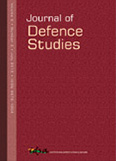Understanding the Motivation of Pakistan’s Security and Defence Policies: Roots of Pakistan’s Emergence as the Epicentre of Terrorism
The idea of Pakistan survives on the premise of enmity towards India. This premise came into existence well before Pakistan became a reality. Some in Pakistan believe that the country started incubating the moment the first Muslim stepped on the soil of the subcontinent. That belief originates from the conviction that the Islamic civilisation cannot intermingle with another civilisation because it always seeks to conquer and subjugate.
- A K Verma |
- October 2011 |
- Journal of Defence Studies





